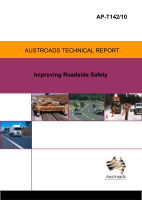Road Safety

- Publication no: AP-T142-10
- ISBN: 978-1-921551-95-6
- Published: 5 April 2010
- PDF (free) Download
Roadside hazards pose a major risk to road users who lose control of their vehicles and run off the road. From 2003 to 2007, an average of 558 fatal run-off-road crashes occurred annually in Australia and 135 in New Zealand. In addition to these, across both countries there were more than 14,000 run-off-road crashes causing injuries each year. This report summarises the results of the first year (2008-09) of a program of research aimed at gaining a greater understanding of how to best manage and treat roadside hazards in both urban and rural areas.
This year’s component of the study examined the safety of barriers at varying offset distances from trafficked lanes, the provision of forgiving roadside furniture and protection from impact with rigid objects, with an emphasis on poles, the retrofitting of barriers to lessen crash severity, the potential to reduce the severity of motorcyclist collisions with barriers, the crash characteristics associated with all roadside hazards, knowledge gaps in the treatment of roadside hazards for future research. Keeping in mind the stated aims of the project and a necessity to ensure that the research assists road authorities in following Safe System principles, three broad areas of research are recommended as the project continues the refinement of clear zone guidelines, best practice in the management of roadside environments, correct use of existing and new safety barrier technology (including enhancements to motorcyclist safety).
- Improving Roadside Safety
- Project Manager
- Austroads membership
- 1. INTRODUCTION
- 1.1. Alignment with the Safe System Philosophy
- 2. CRASH DATA ANALYSIS
- 2.1. Limitations of the Crash Analysis
- 2.2. Crashes According to Type
- 2.2.1. By Crash Group
- 2.2.2. By Urban/Rural Environment
- 2.3. Crashes According to Severity
- 2.3.1. By Jurisdiction
- 2.3.2. By Year
- 2.3.3. By Object Struck
- 2.3.4. By Vertical and Horizontal Alignment
- 2.3.5. By Speed Limit
- 2.3.6. By Road Surface Type
- 2.3.7. By Light Conditions
- 2.3.8. By Time of Day
- 2.3.9. By Weather and Atmospheric Conditions
- 2.3.10. By Number of Vehicles Involved
- 2.3.11. By Type of Vehicle
- 2.4. Summary
- 3. LITERATURE REVIEW
- 3.1. Lateral Offsets to Roadside Hazards
- 3.1.1. Recent Research on Modified Clear Zone Procedures
- 3.1.2. Additional Parameters
- 3.1.3. Future Directions for Clear Zone Methods
- 3.2. Forgiving Roadsides
- 3.2.1. Building a Forgiving Roadside
- 3.2.2. Impact Attenuators
- 3.2.3. Frangible Poles
- 3.2.4. Flexible Poles and Guideposts
- 3.2.5. Roadside Hazard Severity
- 3.3. Retrofitting Roadside Safety
- 3.3.1. Removal, Relocation and Modification of Hazards
- 3.3.2. Roadside and Median Barriers
- 3.3.3. New and Innovative Crash Barrier Systems
- 3.3.4. Median Barriers
- 3.3.5. Median Barriers on Single-carriageway Roads
- 3.4. Motorcycle-friendly Safety Barriers
- 3.4.1. Mechanisms of Motorcyclist Injury due to Safety Barriers
- 3.4.2. Injuries from Barrier Collisions
- 3.4.3. A Selection of Available Modifications
- 3.5. Summary of Literature Review
- 4. SITE VISITS
- 4.1. Site Investigations
- 4.1.1. Features Investigated
- 4.2. Key Findings of the Site Investigations
- 4.3. Discussion
- 5. CONSULTATION
- 5.1. Use of New Barrier Technologies
- 5.1.1. Motorcycle-friendly Modifications
- 5.1.2. New Barrier Systems
- 5.1.3. Lack of Research Information on Effectiveness of Barriers
- 5.2. Heavy Vehicle Compatible Roadsides and Barriers
- 5.3. Frequency and Cost of Repairs to Wire Rope Barriers
- 5.4. Roadside Vegetation
- 5.5. Roadside Trees
- 5.6. Existing Roadside Object Databases
- 5.7. Safety Barrier Installation Records
- 5.8. New Roadside Object Database
- 5.9. Applicability of Guidelines and Research
- 5.10. Other Research Requirements
- 6. FUTURE RESEARCH
- 6.1. Refinement of Clear Zone Guidelines
- 6.2. Management of Roadside Environments
- 6.3. Effective Use of Barrier Technology
- Encroachment probability calculation
- Modelling of varying road engineering parameters
- Modelling of various roadside surface treatments
- The effect of shoulder width
- Review of permissible roadside tree diameters
- Improvement of knowledge on barrier effectiveness
- Heavy vehicle barrier requirements
- Median barriers
- 7. CONCLUSION
- Refinement of clear zone guidelines
- Management of roadside environments
- Effective use of barrier technology
- REFERENCES
